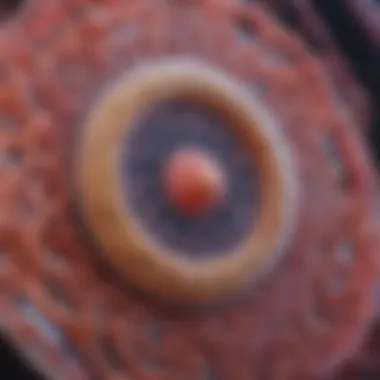The P53 Plasmid: Exploring Tumor Suppression Mechanisms


Intro
The study of cancer has long relied on understanding the mechanisms that regulate cell growth and division. One such molecule of great interest is the p53 protein, known as the guardian of the genome due to its role in maintaining genomic stability. Derived from this protein, the p53 plasmid serves as an essential tool in cancer research and gene therapy. This article aims to explore the intricacies of the p53 plasmid, including its structure, function, and relevance in tumor suppression. By dissecting various aspects of this vital genetic instrument, the article seeks to impart a comprehensive understanding to students, researchers, educators, and professionals in the field.
Research Highlights
Key Findings
The p53 plasmid is not just a molecular tool; its design plays a significant role in the modulation of cellular responses to stress. Key findings surrounding the p53 plasmid include:
- Essential role in apoptosis: The plasmid enhances the apoptotic pathways in cancer cells, leading to cell death.
- Transcription regulation: It influences the expression of numerous genes involved in the cell cycle and DNA repair.
- Tumor growth inhibition: Studies indicate that introducing the p53 plasmid into tumor cells significantly reduces tumor size in various animal models.
Implications and Applications
The implications of using the p53 plasmid in cancer research are vast. Some notable applications are:
- Gene therapy: The plasmid serves as a delivery mechanism to express p53 in tumor cells, reviving its tumor-suppressing functions.
- Biomarker development: It aids in the identification of biomarkers related to p53, improving cancer diagnostics and patient management.
- Therapeutic development: The insights gained from p53 plasmid studies inform the development of targeted therapies that exploit the pathways regulated by p53.
"Understanding the p53 plasmid offers a glimpse into a smarter cancer treatment strategy, one that harnesses the body's own mechanisms to fight malignancy."
Methodology Overview
Research Design
The research surrounding the p53 plasmid adopts a multifaceted design. Primarily, it involves both in vitro and in vivo studies to assess the plasmid's efficacy in different cellular environments. Experimental setups typically include:
- Cell culture experiments: To observe the direct effects on cancer cell lines.
- Animal models: For understanding the plasmid's impact on tumor growth and progression in living organisms.
Experimental Procedures
Experimental procedures for testing the p53 plasmid often encompass:
- Plasmid construction: Designing and cloning the p53 gene into an appropriate vector.
- Transfection: Introducing the p53 plasmid into cancer cells using methods like electroporation or liposomal transfection.
- Analysis of outcomes: Evaluating the effects on cell viability, apoptosis rates, and gene expression profiles through techniques such as qPCR and western blotting.
In summary, the p53 plasmid is a pivotal subject of study in molecular genetics and oncology. Its potential to reshape cancer research and usher in innovative therapeutic strategies cannot be understated.
Prolusion to P53 and Its Role in Cancer Biology
Understanding the role of the P53 protein in cancer biology is essential for grasping the complexities behind tumor suppression mechanisms. P53, often dubbed the "guardian of the genome," serves as a critical regulator of the cell cycle. This regulation directly influences cell growth and division, making it a focal point in cancer research. The P53 protein's activities range from repairing damaged DNA to inducing apoptosis in cells that cannot be salvaged. This makes it a pivotal element in protecting cells from becoming cancerous.
The importance of studying P53 lies not only in its biological functions but also in its associations with various types of cancers. Mutations in the TP53 gene, which encodes the P53 protein, are found in approximately 50% of human tumors. This prevalence highlights the urgency of understanding how P53 operates and how its dysfunction contributes to cancer progression. The exploration of these mechanisms can lead to innovative therapeutic strategies aimed at restoring P53 function in cancerous cells.
Below, we will explore the historical background of the P53 protein, its key functions in cell cycle regulation, and the severe impacts of its mutations on cancer development.
Historical Background of the P53 Protein
The discovery of P53 dates back to the early 1970s when it was first identified as a protein associated with transforming properties in oncogenic viruses. Researchers initially viewed it as an oncogene, but subsequent analysis revealed its true role as a tumor suppressor.
By the 1980s, studies began to highlight the protective role P53 plays in maintaining genomic integrity. The gene TP53 was cloned, and its responsibility in cancer biology started gaining prominence. Scientists have since delineated the mechanisms through which P53 executes its functions, leading to a deeper understanding of its paradoxical roles in tumorigenesis.


P53's Function in Cell Cycle Regulation
P53 regulates the cell cycle primarily at the G1 phase, serving as a checkpoint that assesses cellular stress and DNA integrity. When P53 senses damage or abnormalities in the cell, it activates genes that can pause the cell cycle, allowing for DNA repair or promoting apoptosis if the damage is irreparable. This function is vital in preventing the propagation of cells with genetic defects, often acting as a safeguard against tumor formation.
- Activates CDKN1A which encodes the p21 protein, inhibiting cyclin-dependent kinases.
- Induces GADD45, promoting DNA repair mechanisms.
- Triggers pro-apoptotic signals when damage is too severe.
The role of P53 in regulating the cell cycle underscores its importance as a cellular guardian. Disruptions to this regulation can lead to unchecked cell division.
Impact of P53 Mutations in Cancer Development
Mutations in the TP53 gene adversely affect the protein’s ability to perform its functions. These mutations often result in a loss of tumor suppressive capabilities, thereby contributing to the destabilization of the genome. With compromised P53 activity, cells can bypass checkpoints, leading to uncontrolled proliferation.
It is noteworthy to mention some specific common mutations:
- Missense mutations typically alter a single amino acid in the P53 protein, affecting its DNA-binding ability.
- Frameshift mutations can lead to truncated proteins that lose functions critical for tumor suppression.
As a result, cancers associated with TP53 mutations tend to exhibit more aggressive behavior and poorer outcomes. Understanding these mutations is crucial for the development of targeted therapies aimed at restoring P53 function or mimicking its tumor-suppressive actions.
Ultimately, P53’s diverse roles and hundreds of interactions within the cell underline its significance in both cancer prevention and the prognosis of cancer patients.
Understanding the P53 Plasmid
The P53 plasmid has emerged as a pivotal tool in molecular biology, particularly in cancer research and therapies. Understanding the P53 plasmid allows researchers to explore its mechanisms of action, develop innovative therapies, and investigate its potential to alter cancer progression. As we delve into the subsequent sections, it becomes clear that this genetic vector provides crucial insights into tumor suppression influenced by the P53 protein. The significance of the P53 plasmid cannot be overemphasized, given its capacity to reflect and enhance our understanding of how the body’s defense mechanisms against cancer can be utilized and improved upon.
Definition of a Plasmid in Molecular Biology
In molecular biology, a plasmid is a small, circular piece of DNA that is distinct from chromosomal DNA. Plasmids can replicate independently and are often found in bacteria. They serve as vehicles for genetic information transfer, especially in genetic engineering. When scientists manipulate plasmids, they typically insert specific genes. This can enable the study of genes and their functions or express products like proteins. Plasmids are essential in cloning, gene expression, and various other biotechnological applications.
The Relationship Between P53 and Plasmids
P53, known as a tumor suppressor protein, plays a key role in regulating the cell cycle and preventing tumor formation. The relationship between P53 and plasmids is significant. Scientists utilize P53 plasmids to study the biology of cancer and explore therapeutic avenues. By introducing modified P53 genes into cells via plasmids, researchers can observe how P53 modulates tumor progression. This relationship allows the P53 gene’s protective effects to be harnessed in genetic therapies, illustrating the potential of plasmids as effective tools for targeted cancer treatments.
Structural Features of the P53 Plasmid
The structural features of the P53 plasmid are essential to its functionality. Typically, a P53 plasmid includes the following components:
- Promoter Region: This is a sequence that initiates transcription. It is crucial for ensuring that the P53 protein is produced at appropriate levels.
- Multiple Cloning Site (MCS): This area allows scientists to insert the desired P53 gene or relevant sequences. Enhancements can also be introduced within this site.
- Selectable Marker: Markers such as antibiotic resistance genes are included to select cells that have successfully taken up the plasmid. This enables researchers to confirm the efficacy of gene delivery.
- Origin of Replication: This sequence allows the plasmid to replicate within host cells independently.
By understanding these structural features, researchers can optimize P53 plasmids for various applications such as gene therapy or functional studies in cancer biology.
Mechanisms of Tumor Suppression by P53
The mechanisms of tumor suppression by the p53 protein are fundamental to understanding its role in cancer biology. The p53 protein helps protect cells from becoming cancerous through a variety of pathways. By engaging various cellular processes, p53 acts as a guardian of the genome. This section will delve deeply into specific mechanisms including the activation of DNA repair pathways, induction of apoptosis in cells with irreparable damage, and inhibition of angiogenesis and tumor growth.
Activation of DNA Repair Pathways
There is compelling evidence supporting the role of p53 in the activation of DNA repair mechanisms. When DNA damage occurs, p53 senses the stress signals and orchestrates a response. This involves the upregulation of genes required for repair processes. Such responses include the activation of nucleotide excision repair, which corrects bulky DNA adducts, and homologous recombination repair, critical in fixing double-stranded breaks.
The importance of this activation cannot be overstated. It ensures genomic integrity, subsequently preventing mutations that may foster malignant transformation. p53 functions as a transcription factor, enhancing the expression of essential proteins involved in these repair pathways, including p21 and GADD45. By amplifying these processes, p53 solidifies its role as a critical player in maintaining cellular homeostasis and preventing cancer progression.


Induction of Apoptosis in Damaged Cells
Apoptosis, or programmed cell death, is a vital mechanism wherein p53 serves a critical function. When cells sustain irreparable DNA damage, p53 is activated to induce apoptosis. This is paramount in mitigating the risk of cells becoming cancerous due to accumulated genetic alterations.
When p53 detects severe damage, it triggers a series of intracellular signals. This culminates in the expression of pro-apoptotic genes, such as BAX and PUMA. Ultimately, these signals lead to mitochondrial outer membrane permeabilization and the activation of caspases, which orchestrate cellular dismantling in a controlled manner. This mechanism underscores the essential role of p53 in eliminating potentially cancerous cells, thus limiting tumor development.
Inhibiting Angiogenesis and Tumor Growth
Angiogenesis refers to the formation of new blood vessels, a process often co-opted by tumors to sustain their growth. p53 plays a role in inhibiting angiogenesis, thus affecting tumor progression. This inhibition occurs via the transcriptional regulation of several anti-angiogenic factors.
Notably, p53 enhances the expression of genes such as thrombospondin-1 and angiostatin, both of which are potent inhibitors of blood vessel formation. By limiting blood supply to tumors, p53 effectively deprives them of oxygen and nutrients, thereby suppressing tumor growth. The ability of p53 to suppress angiogenesis underlines its multifaceted role in cancer biology, reinforcing its significance as a tumor suppressor.
In summary, p53's multifaceted mechanisms of tumor suppression exhibit its crucial role in cancer biology. Through the activation of DNA repair pathways, induction of apoptosis, and inhibition of angiogenesis, p53 preserves cellular integrity and prevents the onset of tumors. Understanding these mechanisms reveals the therapeutic potential of p53-based strategies in cancer treatment.
Applications of the P53 Plasmid in Research
The P53 plasmid has emerged as a significant tool in cancer research, facilitating various applications that extend beyond understanding tumor suppression mechanisms. Its ability to modulate the expression and function of the p53 protein allows researchers to explore cellular responses under different conditions, thereby advancing knowledge in molecular biology and therapeutic strategies.
Gene Therapy Approaches Using P53 Plasmids
Gene therapy using P53 plasmids aims to restore normal p53 function in cancer cells where it is frequently mutated. This approach can help reactivate critical pathways involved in tumor suppression. Researchers introduce these plasmids into affected cells, thereby promoting p53 expression. This eventual restoration can induce cell cycle arrest and facilitate apoptosis in malignant cells. Evidence suggests that delivering P53 plasmids can significantly decrease tumor size in various preclinical models. Importantly, this type of therapy aims to avoid the side effects associated with traditional therapies, which often harm both cancerous and healthy cells.
Creating Animal Models for Cancer Research
The P53 plasmid serves as a foundational element in developing animal models that simulate human cancers. By introducing specific mutations or overexpressing p53, researchers can generate mice or other organisms that reflect the complex behavior of tumors found in humans. These models are paramount for testing new therapeutic approaches and understanding the tumor's biology better. It allows scientists to observe the progression of cancer and the effectiveness of treatment protocols over time, thus providing critical insights that could inform clinical strategies.
P53 Plasmids in Drug Development
In the realm of pharmacology, P53 plasmids contribute significantly to drug development processes. By examining the interaction between drugs and p53 pathways, scientists can identify compounds that enhance p53 functionality or restore its activity in certain types of cancer. This can lead to the discovery of novel agents that selectively target tumors with p53 deficiencies. Moreover, understanding how drugs influence p53 can facilitate the design of combination therapies that leverage the synergistic effects of multiple treatments. The integration of P53 plasmids into drug discovery not only enhances therapeutic options but also improves the precision of cancer treatment.
The innovative applications of P53 plasmids in research offer promising avenues for advancing cancer therapies and improving patient outcomes.
In summary, the P53 plasmid plays an integral role in cancer research. Its applications in gene therapy, animal model creation, and drug development highlight its versatility in yielding deeper insights into tumor biology and improving therapeutic interventions.
Challenges in Utilizing the P53 Plasmid
The application of the P53 plasmid in cancer research and therapy presents numerous hurdles that must be addressed for effective utilization. Understanding these challenges is crucial for researchers aiming to implement gene therapy strategies that exploit the p53 gene’s tumor-suppressing capabilities. This section outlines specific challenges such as immune responses, delivery mechanisms, and ethical considerations that may impact the success and acceptance of P53-based therapies.
Potential Immune Responses to Gene Therapy
One significant challenge in using P53 plasmids lies in potential immune responses triggered by the introduction of foreign genetic material into the human body. The immune system is adept at identifying and attacking perceived threats, including plasmids designed for gene therapy. This immune response can lead to the neutralization of the therapeutic effect of the P53 plasmid and can even result in adverse reactions.
When a plasmid enters the body, dendritic cells and macrophages may present the derived antigens to T-cells, activating an immune response that targets both the plasmid and its proteins. Consequently, high levels of neutralizing antibodies may be generated, which could compromise the efficacy of subsequent treatments. Moreover, inflammation can hinder the effectiveness of gene therapy by creating a hostile environment for cellular uptake.
Research into methods for minimizing immune responses is ongoing. For instance, the use of biodegradable nanoparticles or liposomes may help shield the plasmid from immune detection. Additionally, strategies to modulate immune responses or to make the plasmid less immunogenic are vital for enhancing the safety and efficacy of p53 plasmid therapies.
Delivery Mechanisms for Plasmids: Limitations and Innovations
The efficiency of P53 plasmid delivery to target cells is another critical challenge. Various delivery methods, such as viral vectors, electroporation, and microinjection, have been utilized, but each comes with its own set of limitations. For example, viral vectors can sometimes lead to unintended genetic integration, posing a risk of oncogenesis.


Electroporation, while effective in some contexts, may not be suitable for all cell types and can induce excessive cell stress. Non-viral methods, like liposomal delivery, offer lower immunogenicity but often suffer from limited endosomal escape, which hampers the therapeutic gene's access to the nucleus where it is needed.
Innovations are being explored to improve delivery. Technologies such as CRISPR/Cas9 for genome editing may provide advantageous routes for introducing p53 plasmids in a more controlled manner. Advanced research in biomaterials and synthetic biology may offer new avenues for enhancing the effectiveness of P53 plasmid delivery.
Ethical Considerations in Gene Therapy Research
The use of the P53 plasmid in gene therapy raises various ethical concerns that cannot be overlooked. Ethical dilemmas exist regarding informed consent, the safety of the procedures involved, and the potential long-term effects of gene manipulation. As this field progresses, questions regarding equitable access to therapies, especially for marginalized communities, also come to the forefront.
Informed consent is essential in gene therapy research. Patients must fully understand the experimental nature of such treatments, including potential risks and benefits. The complexity of gene therapy can make it challenging for individuals to grasp these concepts completely, leading to ethical considerations about whether true informed consent is achievable.
The safety of administering P53 plasmids also requires stringent ethical scrutiny. As the field continues to evolve, regulatory bodies must ensure that the risks are clearly communicated, and treatment protocols adhere to safe practices.
Additionally, the long-term consequences of gene therapy on future generations raise questions about potential unforeseen outcomes. Researchers and ethicists alike must engage in ongoing discussions to navigate these challenges responsibly, ensuring that advancements in gene therapy lead to positive outcomes without compromising ethical standards.
Future Directions in P53 Research
The exploration of the p53 plasmid is a critical frontier that holds promise for overcoming cancer. Advancing our understanding in this area can potentially reshape therapeutic strategies. As cancer continues to evade conventional treatments, research focuses on refining genetic interventions. This makes the p53 plasmid an essential tool in gene therapy, and thus warrants detailed investigation.
Advancements in Plasmid Engineering
Recent developments in plasmid engineering have transformed how we approach cancer therapies. Innovative techniques allow for enhanced plasmid stability and delivery. By optimizing the size and structure of plasmids, researchers can improve their effectiveness. This results in better gene expression and targeted therapies. Such enhancements are vital for the successful use of p53 plasmids in clinical settings.
Key advancements include:
- Modular Plasmid Design: This allows researchers to insert functional sequences easily.
- Improved Delivery Systems: Nanoparticles and viral vectors are in development to streamline the delivery of p53 plasmids into affected cells.
- Increased Bioavailability: New methods are being studied to enhance the survival of plasmids in the bloodstream, which can lead to enhanced therapeutic effects.
Integrative Approaches in Cancer Therapy
Integrating the p53 plasmid into existing cancer treatment modalities presents a holistic approach to therapy. This encompasses the combination of traditional methods, such as chemotherapy and radiotherapy, with innovative genetic interventions. By synergizing therapies, it is possible to achieve a greater impact on tumor reduction while minimizing resistance.
For instance, using p53 plasmids concurrently with chemotherapy can:
- Enhance Sensitivity: Tumors may become more sensitive to drugs through p53-mediated pathways.
- Counteract Resistance: The plasmid can help address resistance mechanisms, potentially leading to better patient outcomes.
Potential of Combination Therapies
Combination therapies represent a significant frontier in the fight against cancer. The potential of using p53 plasmids alongside other targeted therapies or immunotherapies is a promising avenue for research.
Such combinations enhance the chances of treatment efficacy. This is crucial for complex cancer types that display varied responses to single treatments. In particular:
- Synergistic Effects: Combinations may result in effects that are greater than the sum of their parts.
- Broader Response: Tumors with diverse genetic profiles may respond better to combined interventions.
The End and Summary of Findings
The exploration of the P53 plasmid culminates in a better understanding of its role in cancer biology and gene therapy. This section synthesizes the critical elements discussed throughout the article and assesses the overall impact of the P53 plasmid on future research and treatment strategies.
Recap of the Importance of P53 and Its Plasmid
The P53 protein is known as the guardian of the genome. Its primary function includes regulating the cell cycle and promoting apoptosis in response to DNA damage. The P53 plasmid, derived from the P53 gene, serves as a powerful tool in molecular biology. By introducing the P53 plasmid into various cellular models, researchers can assess P53’s role in cancer suppression.
Notably, the plasmid helps in evaluating how P53 mutations contribute to tumorigenesis. The design and function of the P53 plasmid allow for targeted therapies, which can minimize side effects compared to broader approaches, like chemotherapy.
Ultimately, the importance of the P53 plasmid is multifaceted, serving not only as a research tool but also holding potential for therapeutic applications.
Implications for Cancer Research and Therapy
The implications of the P53 plasmid extend into several critical areas of cancer research and therapy. First, the plasmid can facilitate advancements in gene therapy, where it could restore normal P53 function in tumors deficient in this protein. This restoration can lead to enhanced DNA repair and reduced tumor growth.
Second, the development of animal models using the P53 plasmid provides deeper insight into tumor biology. These models can closely mimic human cancer, allowing for more effective testing of new drugs and therapeutic strategies.
Moreover, the P53 plasmid plays a role in combination therapies. It can be used alongside traditional treatments to enhance overall efficacy. The integration of P53 plasmids into current treatment protocols may open new avenues for attacking tumors that were previously resistant to therapy.
Finally, ongoing research into the P53 plasmid continues to uncover its potential uses in diagnostics and prognosis, especially in identifying tumor types and predicting patient outcomes.
In summary, the P53 plasmid is a vital component in the toolkit of cancer researchers and clinicians. Its capability to modulate tumor suppressor pathways positions it as a central figure in contemporary cancer therapies.



